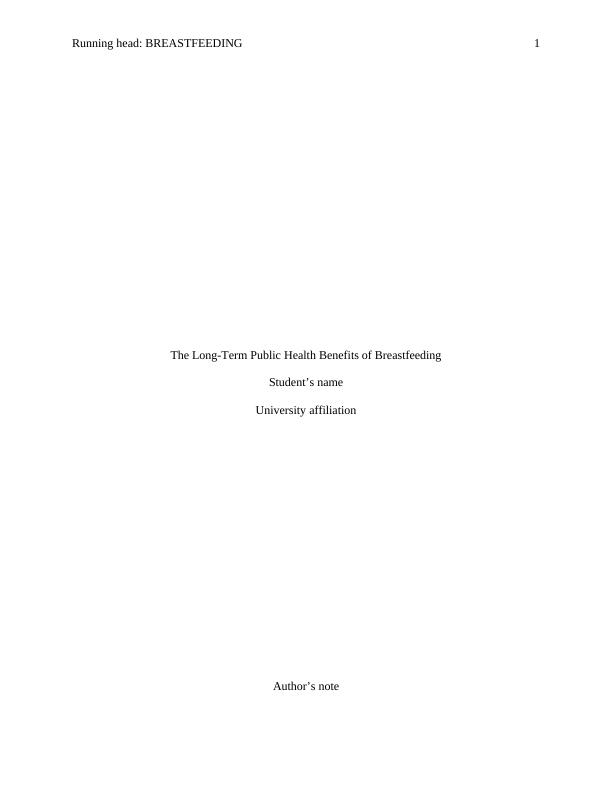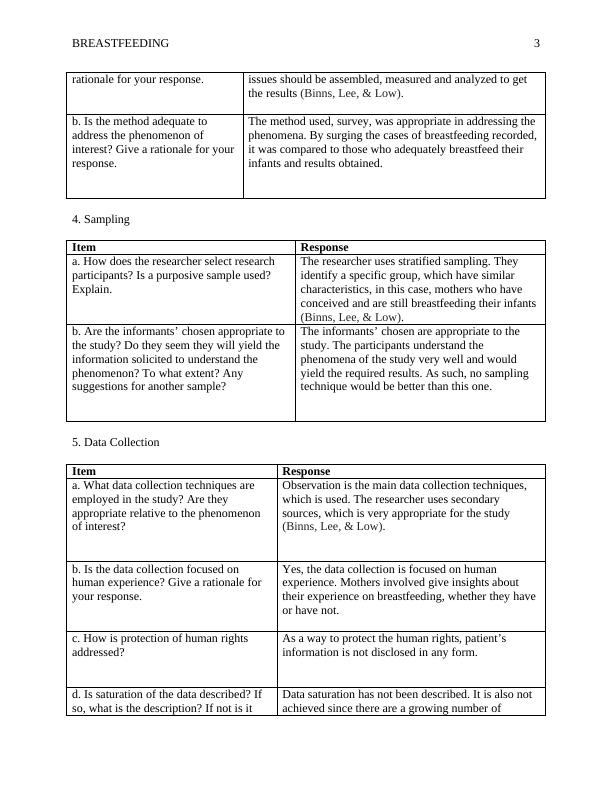Long-Term Public Health Benefits of Breastfeeding
Added on 2022-08-28
7 Pages1647 Words27 Views
Running head: BREASTFEEDING 1
The Long-Term Public Health Benefits of Breastfeeding
Student’s name
University affiliation
Author’s note
The Long-Term Public Health Benefits of Breastfeeding
Student’s name
University affiliation
Author’s note

BREASTFEEDING 2
The Long-Term Public Health Benefits of Breastfeeding
1. Statement of the Phenomenon of Interest
Item Response
a. What is the phenomenon of
interest? Is it clearly identified?
What is it? How is it identified?
The article mainly mentions about the importance of
mothers breastfeeding. Ideally, the article identifies
benefits and how breastfeeding has helped reduce certain
chronic diseases (Binns, Lee, & Low).
b. Has the researcher included an
explanation about why the
phenomenon requires a qualitative
format? Does the explanation
seem clear and logical?
Despite not mention why the research would use a
qualitative approach, it is evident that it would be vital.
For instance, the article explains the underlying reasons
about breastfeeding chronic diseases and later gives
insights on how it helps the mothers and infants. In
essence, the explanation in the entire article is clear and
logical.
2. Purpose
Item Response
a. What is the purpose of the
study and is it made explicit?
Give a rationale for your
response.
The purpose of the article is to establish the health benefits
involved with breastfeeding to mothers and infants. First, the
study starts by explaining why breastfeeding is important. It
further adds on how lack of breastfeeding affects the mother and
infants (Binns, Lee, & Low).
b. Does the researcher
indicate how the research is
significant to nursing? Give a
rationale for your response.
The researcher does not indicate how the research is important
to nursing. However, the explanations they give explain how the
entire concept affects the involved parties.
c. Does the explanation seem
appropriate and logical? Give
a rationale for your response.
The researcher does not give any explanation about the
significance of the research to nursing.
3. Methodology
Item Response
a. What is the tradition or design
of the study? Is it compatible with
the purpose of the study? Give a
The tradition which was used in the research involved data
collection, measurement and analysis of the data. It is very
compatible with the research as data about breastfeeding
The Long-Term Public Health Benefits of Breastfeeding
1. Statement of the Phenomenon of Interest
Item Response
a. What is the phenomenon of
interest? Is it clearly identified?
What is it? How is it identified?
The article mainly mentions about the importance of
mothers breastfeeding. Ideally, the article identifies
benefits and how breastfeeding has helped reduce certain
chronic diseases (Binns, Lee, & Low).
b. Has the researcher included an
explanation about why the
phenomenon requires a qualitative
format? Does the explanation
seem clear and logical?
Despite not mention why the research would use a
qualitative approach, it is evident that it would be vital.
For instance, the article explains the underlying reasons
about breastfeeding chronic diseases and later gives
insights on how it helps the mothers and infants. In
essence, the explanation in the entire article is clear and
logical.
2. Purpose
Item Response
a. What is the purpose of the
study and is it made explicit?
Give a rationale for your
response.
The purpose of the article is to establish the health benefits
involved with breastfeeding to mothers and infants. First, the
study starts by explaining why breastfeeding is important. It
further adds on how lack of breastfeeding affects the mother and
infants (Binns, Lee, & Low).
b. Does the researcher
indicate how the research is
significant to nursing? Give a
rationale for your response.
The researcher does not indicate how the research is important
to nursing. However, the explanations they give explain how the
entire concept affects the involved parties.
c. Does the explanation seem
appropriate and logical? Give
a rationale for your response.
The researcher does not give any explanation about the
significance of the research to nursing.
3. Methodology
Item Response
a. What is the tradition or design
of the study? Is it compatible with
the purpose of the study? Give a
The tradition which was used in the research involved data
collection, measurement and analysis of the data. It is very
compatible with the research as data about breastfeeding

BREASTFEEDING 3
rationale for your response. issues should be assembled, measured and analyzed to get
the results (Binns, Lee, & Low).
b. Is the method adequate to
address the phenomenon of
interest? Give a rationale for your
response.
The method used, survey, was appropriate in addressing the
phenomena. By surging the cases of breastfeeding recorded,
it was compared to those who adequately breastfeed their
infants and results obtained.
4. Sampling
Item Response
a. How does the researcher select research
participants? Is a purposive sample used?
Explain.
The researcher uses stratified sampling. They
identify a specific group, which have similar
characteristics, in this case, mothers who have
conceived and are still breastfeeding their infants
(Binns, Lee, & Low).
b. Are the informants’ chosen appropriate to
the study? Do they seem they will yield the
information solicited to understand the
phenomenon? To what extent? Any
suggestions for another sample?
The informants’ chosen are appropriate to the
study. The participants understand the
phenomena of the study very well and would
yield the required results. As such, no sampling
technique would be better than this one.
5. Data Collection
Item Response
a. What data collection techniques are
employed in the study? Are they
appropriate relative to the phenomenon
of interest?
Observation is the main data collection techniques,
which is used. The researcher uses secondary
sources, which is very appropriate for the study
(Binns, Lee, & Low).
b. Is the data collection focused on
human experience? Give a rationale for
your response.
Yes, the data collection is focused on human
experience. Mothers involved give insights about
their experience on breastfeeding, whether they have
or have not.
c. How is protection of human rights
addressed?
As a way to protect the human rights, patient’s
information is not disclosed in any form.
d. Is saturation of the data described? If
so, what is the description? If not is it
Data saturation has not been described. It is also not
achieved since there are a growing number of
rationale for your response. issues should be assembled, measured and analyzed to get
the results (Binns, Lee, & Low).
b. Is the method adequate to
address the phenomenon of
interest? Give a rationale for your
response.
The method used, survey, was appropriate in addressing the
phenomena. By surging the cases of breastfeeding recorded,
it was compared to those who adequately breastfeed their
infants and results obtained.
4. Sampling
Item Response
a. How does the researcher select research
participants? Is a purposive sample used?
Explain.
The researcher uses stratified sampling. They
identify a specific group, which have similar
characteristics, in this case, mothers who have
conceived and are still breastfeeding their infants
(Binns, Lee, & Low).
b. Are the informants’ chosen appropriate to
the study? Do they seem they will yield the
information solicited to understand the
phenomenon? To what extent? Any
suggestions for another sample?
The informants’ chosen are appropriate to the
study. The participants understand the
phenomena of the study very well and would
yield the required results. As such, no sampling
technique would be better than this one.
5. Data Collection
Item Response
a. What data collection techniques are
employed in the study? Are they
appropriate relative to the phenomenon
of interest?
Observation is the main data collection techniques,
which is used. The researcher uses secondary
sources, which is very appropriate for the study
(Binns, Lee, & Low).
b. Is the data collection focused on
human experience? Give a rationale for
your response.
Yes, the data collection is focused on human
experience. Mothers involved give insights about
their experience on breastfeeding, whether they have
or have not.
c. How is protection of human rights
addressed?
As a way to protect the human rights, patient’s
information is not disclosed in any form.
d. Is saturation of the data described? If
so, what is the description? If not is it
Data saturation has not been described. It is also not
achieved since there are a growing number of

End of preview
Want to access all the pages? Upload your documents or become a member.
Related Documents
Sourcing, Identifying, and Evaluating Evidence Assignmentlg...
|7
|827
|37
Nursing Research On Critical Analysislg...
|7
|2191
|16
Evidence-Based Practice NSG 5210lg...
|7
|2555
|23
Tool for Critiquing Qualitative Research | Assessment Templatelg...
|11
|5235
|22
